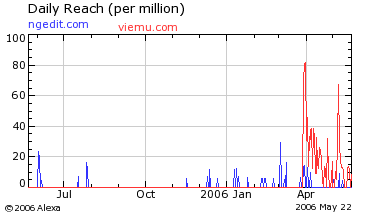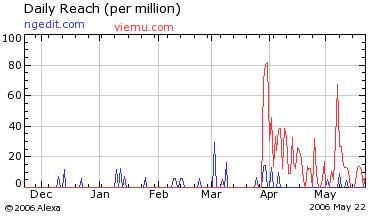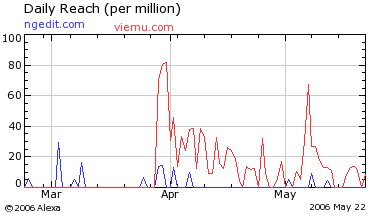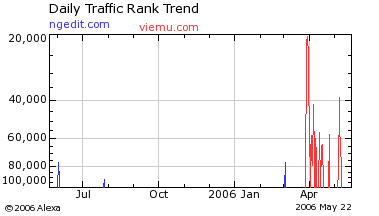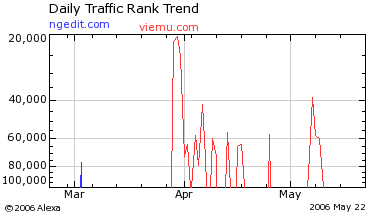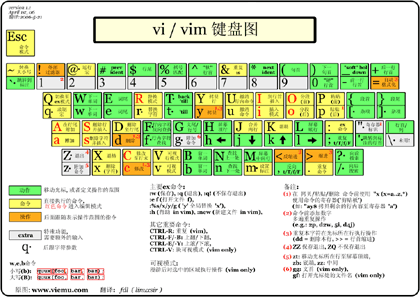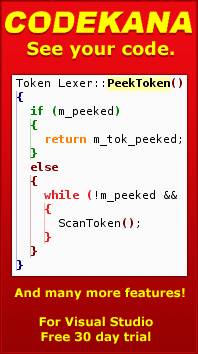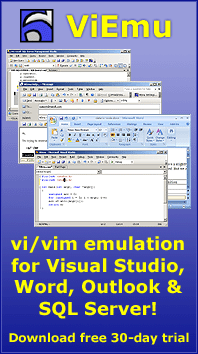October ’06 Status update
Saturday, October 28th, 2006It’s way past time I updated the blog with some more recent info. I hope you’ll understand time the 2nd scarcest resource of my single person startup, only right after cash, but very close.
For the past month, I’ve been able to do little more than answer support e-mails, respond to customer’s queries, and take note of the bugs/requests I’ve received. My day-job has required a lot of time and it has been pretty stressful, so I just forgot about trying to actually achieve anything.
I had been pretty busy working in ViEmu for the previous couple of months. I took a quiet August, I started surfing – which I love as a great summer activity – and I worked a lot in ViEmu/VS version 2.0. The worst part of it was a more than 10 hour symbol-less assembly debugging session of the innards of Visual Studio, in order to find a bug in one of the APIs and implement a feature I badly wanted to offer in 2.0 (automatic keybinding removal/management).
After this, I was able to release ViEmu/VS 2.0 back in mid September. The keybindings handling feature in particular has caused some trouble, so I will completely change the approach for the next major version (whenever that happens), but, all in all, 2.0 is a heck of an improvement over the previous 1.4 version. Sales have gone up, the feedback has been great, and I’m very satisfied with the result. It also makes use of the completely new ngvi emulation engine, which is also integrated in kodumi (my upcoming text editor), which will hopefully be released in early 2007. Having the engine confirmed to work right by hundreds of users gives me a great confidence in it.
I also released ViEmu for SQL Server Management Studio 2005. It has made a modest debut, with not too many sales, but it should be useful to some folks into heavy DB development, and turns ViEmu in a rounder offer.
I’ve updated the web site to offer ViEmu/SQL too, but I only did the minimum investment of time into this. And the reason is that I still plan to release a third ViEmu product before taking on kodumi development more seriously: ViEmu for Word and Outlook. Quite a few people have asked for it over time, I think integrating the ngvi engine in the Word framework won’t be too much trouble, and the main point is that I expect to make the maximum ROI from the effort invested so far. Vi/vim emulation will never be a huge market, and implementing it for many other environments wouldn’t be a sensible business decision, but having the triad of ViEmu/VS, ViEmu/SQL and ViEmu/Word+Outlook seems like the best trade-off of effort and potential. ViEmu sales are already in a place where I could live off of it, and adding up a third product could make it a comfortable situation to confront the release of kodumi 1.0 and developing the technology I intend to.
I will have to do a pretty complete redesign of viemu.com presenting the 3 products. And presenting multiple products is always much more difficult than presenting a single one. Given that this effort is in the near future, I decided to do the minimum redesign possible for the release of ViEmu/SQL.
Some interesting facts:
- July and August sales were slow (especially predictable for July, given June had been the last month of the previous pricepoint and I cannibalized a lot of natural July sales), but September managed to catch up with dollar-sales in June (the best selling month ever so far), and October has again broken that record, almost catching up with the maximum ever unit sales in June.
- Finally, viemu.com has made it to the first page of both the “visual studio vi” and “visual studio vim” Google searches. As soon as I have an afternoon to sort it out, I will finally be redirecting the old “ngedit.com/viemu.html” page to “viemu.com”. It’s taken 6 months for Google to acknowledge the new location (I didn’t want to redirect straight away and risk losing the ranking, as it had taken many, many months to have that page on the first page for these very interesting searches).
- I have a chart and an article almost ready, called “The Ultimate WM_KEYDOWN/WM_CHAR Table from Hell”. I’ve had to delve even more deeply in the broken-ness of the Win32 input model, as ViEmu 2.0 has full keyboard mapping support, and it’s simply amazing how broken it is. The previous article on the subject is, funnily, the 2nd Google result for “WM_CHAR”, right after the MSDN reference page, and the 4th or 5th for WM_KEYDOWN (and brings quite some traffic to my site). I believe the new chart will be very useful and it will be pretty popular on del.icio.us, etc… more exposure is always good.
- As always, I still plan to blog profusely… in the future :). I certainly enjoy writing and sharing my experience, and it’s definitely useful for the business, but I still have to prepare ViEmu/Word+Outlook and get kodumi 1.0 ready before I can dedicate more time to blogging. Actually, there is some very interesting technology I am preparing for kodumi (and for other projects afterwards), and I’d love to blog about it. But I don’t have time for everything… As soon as I have a released product which appeals to a higher percentage of developers, it will make more sense to invest in blogging as a means to gain awareness.
- Andrey Butov took the plunge, left his day job, and went fulltime into his business. The effects have already been noticeable: a new web site specialized in Wall Street Programmers, a new design for his main site, etc… He was even so kind as to feature ViEmu/VS in the front page of the new site! When he released his book So You Want To Be A Wall Street Programmer a few weeks ago, I decided to buy it and read it. The reason is not that I intend to ever work in Wall Street, I am as close to 100% sure as possible that I won’t. But I enjoy his writing style, and I was curious about the development industry over there. I found the book as interesting and entertaining as expected, and I also got a good idea of how the internal development in investment firms works. Since my products are and will keep being oriented towards developers, I found that the new knowledge would be useful for better targeting of my upcoming products. I’m familiar of how development works in 2 or 3 different industries, and I’m confident that I can target my products efficiently to those, but I’ve now added another one to the strategy-decisions mixing pot, an industry which can spend a lot of money, so I think I’ll be glad I spent the time to read the book. Recommended.
And a closing note with regards to blogging subjects: I’m doing some core technology development for kodumi. It’s quite probable that the blog will turn towards that subject area: basic computer science, parsers, languages, types, the nature of code and data, etc… I’ll still post about business and other issues, but I plan to blog a lot about the technology – I think it’s pretty groundbreaking and that it will be useful in many areas. So don’t be too surprised if you find a post here talking about really basic stuff (such as “what is a number”, “what is a type”, or “code and data are one and the same thing”).
But if you really, really want to read purely about setting up a small-software-company, you have to head over to Patrick McKenzie’s “MicroISV on a Shoestring” blog. Patrick is a smart guy (“smart” as in “really smart”), and he also writes very well, so his blog is the best account of going from zero to having a working business I’ve found. Recommended, too.







